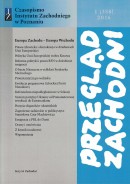Aspekty międzynarodowe Powstania Wielkopolskiego 1918-1919
International Aspects of the Greater Poland Uprising of 1918-1919
Author(s): Stanisław SierpowskiSubject(s): Politics / Political Sciences
Published by: Instytut Zachodni im. Zygmunta Wojciechowskiego
Summary/Abstract: Following the armistice of Compiègne, Greater Poland (Wielkopolska) remained a part of Germany, which meant that the uprising was an internal occurrence and Germans treated it as an organized armed separatist action. The uprising broke out in an atmosphere of enthusiasm for the right of the nations to independence in deciding their fate. The armistice of Treves, signed on February 16, 1919, was a stepping stone in the strife for the rebirth of the Polish state, reuniting the former German, Austrian and Russian sectors of Poland. Due to a lack of an alternative solution, the outcome of this strife was accepted by the Peace Conference. It must be said, however, that France did not consent to such a status quo ante. The other powers also saw a possibility of incorporating Poland into the anti-Bolshevist ‘‘sanitary cordon’’. There was even some competition between Poland and Germany as to which country would be more efficient in fulfilling this role. The Greater Poland uprising (similarly to the Polish issue in general) was treated as part of the policy of the powers toward Germany and Russia. Differences between the powers in their approach to the German issue enabled Berlin to resist the acceptance of the terms of armistice on the German-Greater Poland front negotiated in Poznan´. The German demonstration was accompanied by fears that the loss of vital eastern territories could give rise to numerous problems, perhaps even greater than those generated by the loss of Alsace and Lorraine.
Journal: Przegląd Zachodni
- Issue Year: 327/2008
- Issue No: 04
- Page Range: 73-102
- Page Count: 30
- Language: Polish

